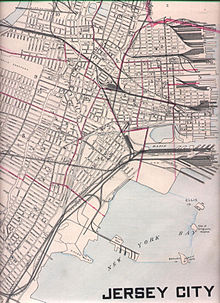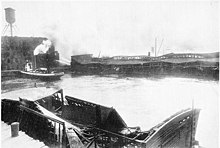Black Tom Explosion
Coordinates: 40 ° 41 ′ 33.68 ″ N , 74 ° 3 ′ 26.47 ″ W The Black Tom explosion was an explosive attack that German agents presumably carried out on July 30, 1916 on the transhipment and storage facility for ammunition on Black Tom Island in Jersey City (New Jersey) perpetrated to prevent the shipment of these goods to the Entente powers - and thus their use in the European theater of war.
Black Tom Island
The term Black Tom originally referred to a small island in New York Harbor that was near Liberty Island . According to a local legend, the island was named after an African-American resident named Black Tom. In 1880, the island was connected to the mainland by a dam that could be used by railways, and from then on it was used as a transshipment point and depot for goods. The island and the embankment later became the property of the Lehigh Valley Railroad Company . Between 1905 and 1916 Lehigh had the island expanded by landfills. The island's area eventually included a mile-long pier on which the depot and warehouse of the National Dock and Storage Company were located. Before and during the war, the primary commodity stored and loaded on Black Tom Island comprised ammunition manufactured in the northeastern United States for export.
Attack on Black Tom Island
On the night of July 30, 1916, shortly after midnight, a series of small fires broke out on the pier. Some guards fled for fear of an explosion of the stored armaments, others tried to put out the fire. The fire brigade, which was finally alerted, was too late - at around 2:00 a.m. the fires had spread to the ammunition in storage and triggered a chain reaction. The setting on fire of some crates of ammunition caused explosions that led to further fires, which in turn engulfed other explosives and caused further explosions. The first and most violent in this series of explosions occurred at 2:08 am. This explosion had the strength of an earthquake with a magnitude of 5.0 to 5.5 on the Richter scale . The shock could still be felt in Philadelphia: Window panes broke up to a distance of 40 kilometers - for example, the glass facades of Times Square were almost completely covered - scraps of metal from the explosions even struck the Statue of Liberty and Ellis Island had to be for safety reasons be evacuated.
A total of 1,000 tons of ammunition, including 50 tons of TNT to be shipped to the UK and France, were destroyed by the explosions. Up to seven people (including police officers, a boat captain and an infant) died. The material damage caused by the explosion is estimated at $ 20 million (about $ 479,764,000 today, adjusted for inflation). The damage to the Statue of Liberty was estimated at around $ 100,000. The damage that the monument suffered from the explosion meant that the actually walk-in torch that the statue is holding in her right hand was closed to visitors after the Black Tom explosion and has not been made accessible again to this day.
consequences
The investigation into the explosion showed that it could not have been an accident, but that it must have been an attack. Their research soon led the investigators to track down a Slovak immigrant named Michael Kristoff. During the interrogation, he stated that two of the guards on Black Tom Island were German agents. Claims soon emerged that employees of the German embassy such as Franz von Rintelen and Karl Boy-Ed were responsible for the attack. The military attaché Franz von Papen , who had already been expelled from the USA in December 1915, was identified as one of the main planners in the American press . He kept his life in fierce replicas against accusations of involvement in the Black Tom attacks, for example in a letter to the editor to Time magazine at the beginning of the 1950s.
After the war, the Lehigh Valley Railroad Company asserted claims for damages against the German Reich, which were negotiated by a mixed commission, the German American Mixed Claims Commission , under the Berlin Treaty in 1921 . In 1939 the commission came to the conclusion that the German Reich had ordered the attacks. In 1953 it was finally agreed on a compensation payment of 50 million US dollars to be paid in installments by the German federal government , which continued until 1979.
Black Tom Island today
Today the area of Black Tom Island has become part of the mainland through further landfills and is located in the southeast of the "Liberty State Park" landscape park. A plaque at the site of the explosion and a picture glass window in the church “Our Lady of Czestochowa” commemorate the victims of the attack.
Creation of terms
For a few years the term "Black Tom" established itself in common parlance in the USA as a term for explosions. In 1941, after the Japanese attack on Pearl Harbor and the subsequent internment of Japanese-born US citizens, President Roosevelt used the term.
literature
- Chad Millman: The Detonators: The Secret Plot to Destroy America and an Epic Hunt for Justice. New York, NY [u. a.] 2006, ISBN 0-316-73496-9 .
- Jules Witcover: Sabotage at Black Tom: Imperial Germany's Secret War in America, 1914–1917. Chapel Hill, NC 1989, ISBN 0-912697-98-9 .
swell
- ↑ a b 101 years ago: The Black Tom explosion shook New York. In: German Spy Museum. July 30, 2017. Retrieved August 8, 2017 .

